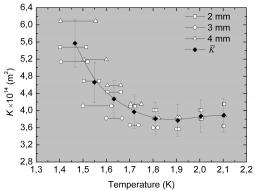
Permeability, as a function of the temperature, for different thicknesses of Al2O3 materials with an identical porosity of 32%. K is the average value of permeability for the three samples. A 10% deviation of K is presented and compared with the dispersion of the results.
It is necessary for manufacturers of superconducting magnets to understand the heat transfer in the windings in order to study thermal stability. For magnets cooled by superfluid helium, such as for example the dipoles and quadrupoles of the LHC, thermal resistance, created by the electrical insulation of the cables, forms the main thermal barrier against cooling. The emergence of Nb3Sn magnets with a strong magnetic field has led designers to research new insulation systems made from ceramic-based materials. These materials can have a lower porosity than conventional insulation and should reduce the helium cooling accordingly.
An experimental system was developed to study of heat transfer through reference samples. In this type of confined environment, the two regimes of heat transfer in superfluid helium are found: the Landau's regime (regime without superfluid vortex) and the regime of Gorter Mellink (regime with vortex). In Landau's regime the measurements confirmed the law of porous mediums (Darcy's law) and showed that material permeability can be extracted from it. This permeability, the capacity for a fluid to pass through it, is dependent on the temperature since the "flow" is not isothermal.
This study also demonstrated the concept of tortuosity in superfluid helium: the thermal or dynamic path depends on the geometry of the porous mediums and not on the thickness. With a high heat flux we find that the Gorter-Mellink regime applies exclusively, where permeability does not play a role but only tortuosity and the heat transfer cross-section. The experimental results showed that the tortuosity varies only by 10% in relation to temperature, which is within the measurement error bar.
